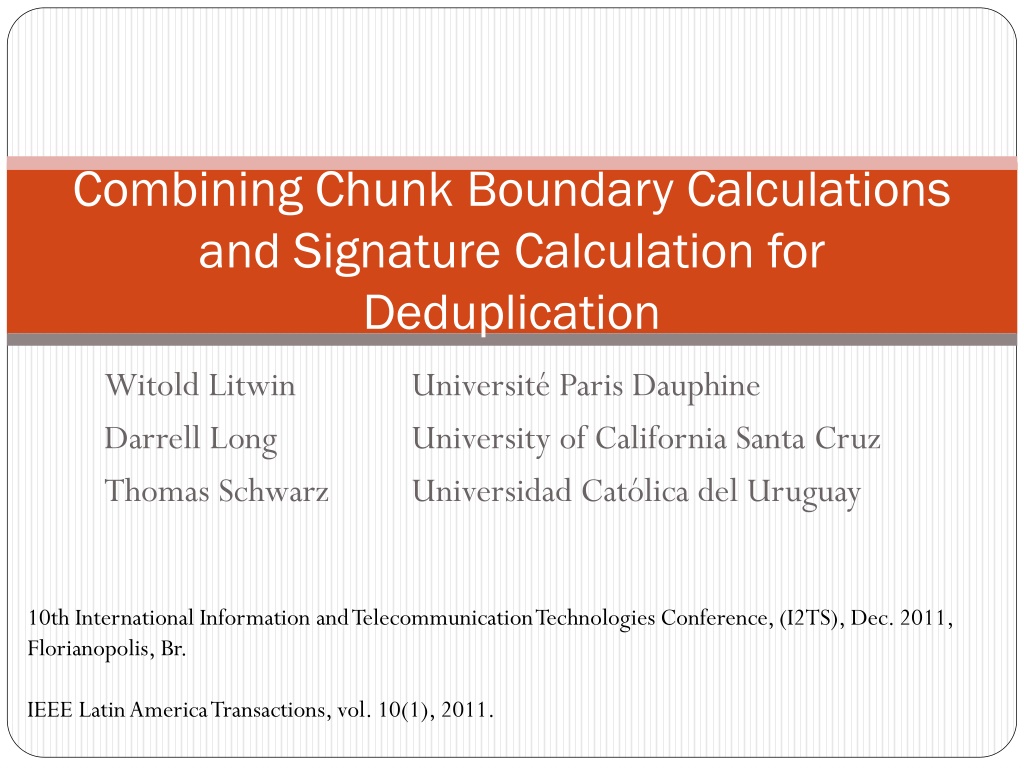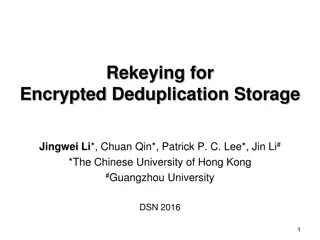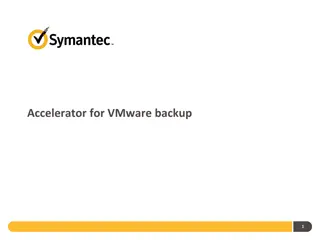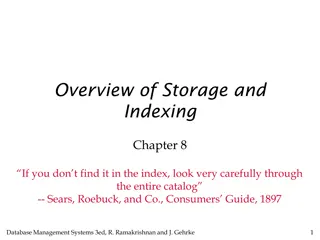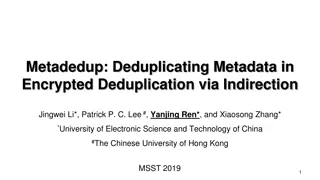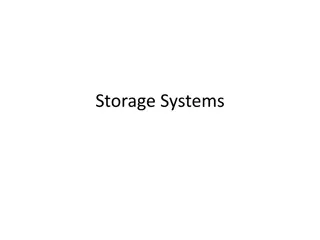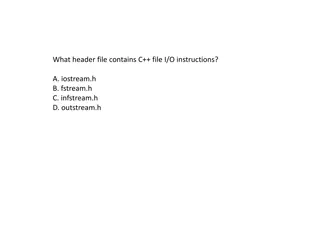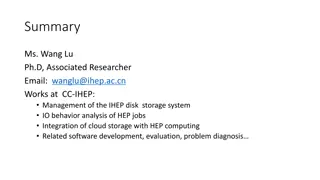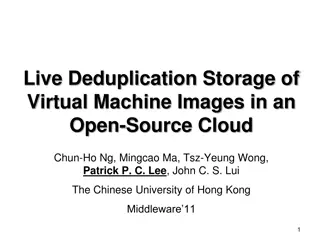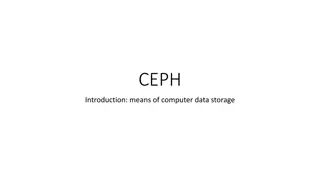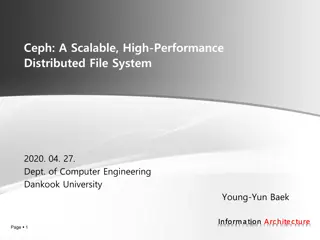Streamlining File Deduplication Process for Efficient Data Storage
Break down data into chunks, calculate signatures, and check for duplicates to optimize storage space. Deduplication method replaces duplicate chunks with pointers, improving write-heavy loads like backup and archival systems. Learn about the challenges and solutions for efficient file storage.
Download Presentation

Please find below an Image/Link to download the presentation.
The content on the website is provided AS IS for your information and personal use only. It may not be sold, licensed, or shared on other websites without obtaining consent from the author. Download presentation by click this link. If you encounter any issues during the download, it is possible that the publisher has removed the file from their server.
E N D
Presentation Transcript
Combining Chunk Boundary Calculations and Signature Calculation for Deduplication Witold Litwin Darrell Long Thomas Schwarz Universit Paris Dauphine University of California Santa Cruz Universidad Cat lica del Uruguay 10th International Information and Telecommunication Technologies Conference, (I2TS), Dec. 2011, Florianopolis, Br. IEEE Latin America Transactions, vol. 10(1), 2011.
Deduplication How not to store the same data twice Breaks data into chunks, calculates signature of chunks, uses signature to check if chunk is already stored If the chunk is already stored, create a file manifest that allows reconstructing the file The chunk is replaced by a pointer to the chunk stored elsewhere Has sometimes horrible read performance, as files need to be reconstructed Is very appropriate for write heavy loads (backup, archival) Is used for web-based storage
Deduplication Is part of storage solutions by all major providers Has impressive compression rates for backup workload Up to 20:1 Zhu, Li and Patterson, 2008 Up to 30:1 Mandagere, Zhou, Smith, and Uttamchandi, 2008
Deduplication Can be for streams (backup workloads) or for files (archival) In the case for files, use a complete file hash to discover identical files Breaks incoming data into chunks Typical value is 4KB or 8KB Calculates the signature of each chunk (hash) Looks up chunk signatures in a data base Create a file manifest: Describes where chunks are Stores new chunks in the system, stores manifest, updates information on chunk signatures
Deduplication incoming stream or file Chunker chunks Calculate Signatures File Manifest: chunk 1 is at chunk 2 is at File Print: file signature chunk sig 1 chunk sig 2 Look up chunks and create file manifest
Deduplication Suffers from two bottlenecks I/O bottleneck: Needs to lookup chunk signatures in a database Proposals: Bloom filter, adaptive caching, extreme binning Needs to scan file twice: To calculate chunk boundaries To calculate chunk signatures Suffers from a leap of faith: There is no time to verify chunk identity byte-by-byte Rely on chunk signature identity to identify identical chunks Advent of MD5 and SHA1 convinced people that the risk of falsely identifying chunks is acceptable
Our proposal Use the calculation of chunk boundaries to strengthen the collision resilience of the chunk signatures
Chunk Boundary Calculation Why not fixed-sized chunks: Small changes to the file cannot be found Fixed sized sliding window Previous Chunk sig 0 sig = 0 Chunk Boundary Chunk Boundary
Chunk Boundary Calculation Context defined chunk definition: A small, local change affects in all likelihood only one chunk If it is located on a chunk boundary, it affects two chunks Deduplication ratio is much higher
Chunk Boundary Calculation Need to calculate a signature of a sliding window Can use rolling hashes When moving the window one letter to the right, can calculate the signature of the new window using: The signature of the old sliding window The character on the left (leaving the sliding window) The character on the right (entering the sliding window) 1. 2. 3.
Chunk Boundary Calculation Can use Rabin Fingerprints (O. Rabin, 1989) Or Algebraic Signatures (Litwin, Schwarz, 2004) We use the latter Because we invented them Because they are marginally better than Rabin Fingerprints for our purpose Both allow cumulative calculation of a signature of the chunk seen so far
Adding to the Chunk Signature Chunk signature is MD5 or SHA1 There are attacks using artificial collisions, but they are theoretical so far There is a small, but positive collision probability Two different chunks share the same signature value Dedup then destroys / alters the later file To keep dedup acceptable, need to have the resulting data loss orders of magnitude less than losses from other sources
Adding to the Chunk Signature Conditions: Want x nines assurance against having any collision in a storage system of size N The number of nines is given by the other failure sources The figure uses x = 6 Conclusion: Adding one byte to the chunk signature increases the possible size of the data set by 101.20412 (for big enough x) Example: MD5 has 16B. At six nines, maximum number of chunks is 8.692 1011 With two bytes more, it is 2.225 1014 Changes from hundreds of petabytes to tens of exabytes
Flatness Signature is flat if the probability of any text to have a certain signature is constant Measuring flatness is difficult No results known for MD5 or SHA-1, though support for almost perfect flatness Algebraic Signatures: Are perfectly flat for complete random input Are very flat for experiment undertaken Short words (taken from password list)
Conclusions Can reuse chunk boundary calculations to strengthen collision resistance of chunk signatures Causes no additional calculation costs
